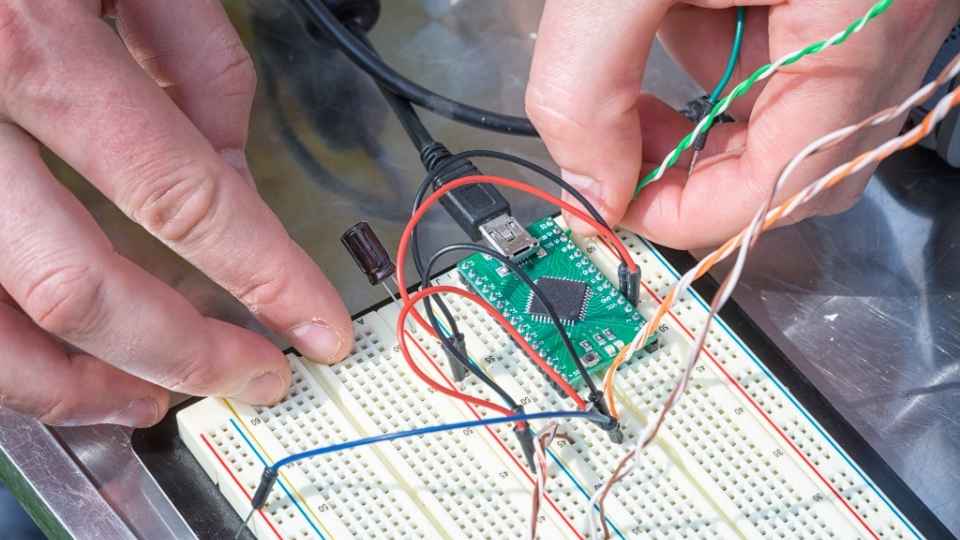
As an electrical engineer, I've always been fascinated by the intricate relationship between voltage, current, and resistance. It's like a dance - each element playing its part in creating a harmonious flow of energy.
But understanding how these factors interact can often feel like trying to unravel a complex puzzle. In this article, I aim to demystify Ohm's Law and shed light on the precise mechanics behind this fundamental principle of electricity.
So fasten your seatbelts and get ready for a journey into the world of voltage, current, and resistance!
Key Takeaways
- Voltage, current, and resistance are fundamental concepts in electricity.
- Ohm's Law states that the current flowing through a conductor is directly proportional to the voltage applied across it, given a constant resistance.
- Increasing resistance restricts the flow of current, resulting in a decrease in the amount of charge passing through a given point per unit time.
- Understanding the impact of resistance helps in understanding how different components affect the flow of current.
The Relationship Between Voltage and Current
You need to understand how voltage and current are related in order to grasp the concept of Ohm's Law.
Voltage is the measure of electric potential difference between two points in a circuit, often referred to as electromotive force (EMF). It's represented by the symbol V and measured in volts (V).
Current, on the other hand, refers to the flow of electric charge through a conductor. It's denoted by the symbol I and measured in amperes (A).
The relationship between voltage and current can be described using Ohm's Law, which states that the current flowing through a conductor is directly proportional to the voltage applied across it, given a constant resistance.

This relationship can be expressed mathematically as I = V/R, where R represents the resistance in ohms (Ω).
Understanding this relationship allows us to manipulate circuits and design systems that meet our desired specifications.
Understanding the Impact of Resistance on Electrical Circuits
Learning about the impact of resistance on electrical circuits can help me understand how different components affect the flow of current. Resistance is a fundamental property that opposes the flow of electric charge in a circuit. It's measured in ohms (Ω) and plays a crucial role in determining the overall behavior of an electrical system.
When resistance increases, it restricts the flow of current, resulting in a decrease in the amount of charge passing through a given point per unit time. This relationship between resistance and current can be described using Ohm's Law: V = I * R, where V represents voltage, I represents current, and R represents resistance.
Exploring the Role of Voltage in Ohm's Law
Exploring the role of voltage in Ohm's Law can provide a deeper understanding of how different electrical components behave in a circuit. Voltage is a fundamental concept in electricity, representing the potential difference between two points in a circuit. Here are four key points to consider:
Voltage is measured in volts (V) and represents the force that drives electric current through a circuit.
In Ohm's Law, voltage (V) is equal to the current (I) multiplied by the resistance (R). This equation, V = IR, shows how voltage affects the flow of current.

Increasing the voltage across a circuit will result in an increase in current, assuming that resistance remains constant.
The direction of voltage is determined by its polarity - positive or negative.
Understanding these concepts allows us to manipulate and control electrical circuits more effectively, providing us with greater freedom to design and optimize our systems.
Analyzing the Effect of Current in Ohm's Law Equations
Analyzing the effect of current in Ohm's Law equations helps us understand how changes in current can impact the overall behavior of a circuit. Current, denoted by the symbol 'I', represents the flow of electric charge through a conductor. It's measured in Amperes (A).
In Ohm's Law, which states that voltage (V) is equal to current multiplied by resistance (R), understanding how changes in current affect the equation becomes crucial. When the current increases, keeping other factors constant, the voltage across a circuit also increases proportionally. This relationship highlights the direct influence of current on electrical systems and emphasizes its significance in determining system behavior.
Now, let's delve deeper into investigating the influence of resistance on electrical systems to gain a comprehensive understanding of Ohm's Law and its applications.
Investigating the Influence of Resistance on Electrical Systems
Take a closer look at how changes in resistance can impact the behavior of electrical systems.

When the resistance in an electrical circuit is altered, it has profound effects on the flow of current and voltage within the system. Here are some key points to consider:
- Resistance and Current: Increasing resistance decreases current flow, while decreasing resistance increases current flow.
- Resistance and Voltage: According to Ohm's Law, increasing resistance leads to a higher voltage drop across that component.
- Power Dissipation: Higher resistance results in more power dissipated as heat, which can affect the efficiency and lifespan of electrical devices.
- System Stability: Careful consideration of resistance values is crucial for maintaining stable operation and preventing damage to components.
Understanding these relationships between resistance and electrical systems empowers individuals with the freedom to design, troubleshoot, and optimize their circuits effectively.
Frequently Asked Questions
What Are Some Real-Life Examples of How Voltage and Current Interact?
In real-life examples, voltage and current interact to power electronic devices like smartphones or laptops. When the voltage is increased, the current also increases, allowing for more power to flow through the device.
How Does the Length and Thickness of a Wire Affect Its Resistance?
The length and thickness of a wire affect its resistance. A longer wire has higher resistance because there is more material for the current to pass through. Thicker wires have lower resistance due to their larger cross-sectional area.
Can You Explain the Concept of Conductance and Its Relationship to Resistance?
Sure, conductance is the measure of how easily electric current flows through a material. It is the reciprocal of resistance and is denoted by the symbol 'G'. Conductance increases as resistance decreases.
What Happens to the Current in a Circuit if the Resistance Is Increased?
If the resistance in a circuit is increased, the current flowing through it decreases. This is because according to Ohm's Law, current is inversely proportional to resistance when voltage remains constant.
How Does Temperature Affect the Resistance of an Electrical Component?
When the temperature of an electrical component increases, its resistance tends to increase as well. This is due to the fact that higher temperatures cause the atoms and electrons in the material to move more vigorously, impeding the flow of current.

 Basic Electronics ConceptsEssential ToolsCircuit Design BasicsMicrocontrollersDIY Electronics ProjectsRoboticsPrivacy PolicyTerms And Conditions
Basic Electronics ConceptsEssential ToolsCircuit Design BasicsMicrocontrollersDIY Electronics ProjectsRoboticsPrivacy PolicyTerms And Conditions
